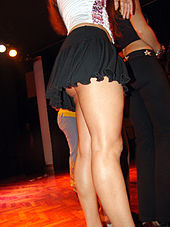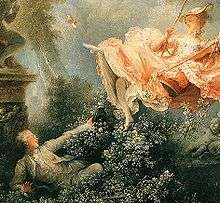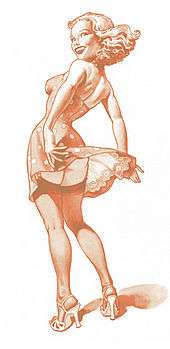Upskirt
Upskirting is the practice of taking non-consensual photographs under a person's skirt or kilt,[1] capturing an image of the crotch area, underwear, and sometimes genitalia. An upskirt is a photograph, video, or illustration which incorporates an image made by upskirting, although the term may also be used to refer to the area inside a skirt, usually from below and while being worn.

The practice is regarded as a form of sexual fetishism or voyeurism and is similar in nature to downblouse photography. The ethical and legal issue relating to upskirt and downblouse photography is one of a reasonable expectation of privacy, even in a public place.
Social attitudes


The term "upskirt" is relatively recent, but the concept and interest therein are not. Looking up a woman's skirt was depicted in the 1767 painting The Swing by Jean-Honoré Fragonard. In "polite society", looking up a lady's skirt was regarded as impolite or rude. In less polite society, looking up a lady's skirt or her lifting up the skirt or otherwise exposing her underwear was regarded as bawdy, as in the case of cabaret dances such as the can-can or in the case of entertainment involving the raising of a dancer's dress by her spinning rapidly. By the polite society, such behaviour was widely judged as indecent.
The sudden popularity in the 1960s of the miniskirt brought the concept out onto the streets, and was viewed by many as mass exhibitionism. One commentator in the 1960s said, "In European countries ... they ban mini-skirts in the streets and say they're an invitation to rape...."[2] By contrast, many women viewed the new style as rebellion against previous clothing styles and as women's liberation of their own bodies. For the first time, many women felt comfortable exposing their thighs, whether on the beach in a swimsuit or in street wear, and were even relaxed when in some situations their underwear would be visible.
Some upskirt and downblouse images originate as innocent fun images which are made with the knowledge and lack of objection of the females affected. However, some of these images can finish up being more widely distributed or being posted onto the Internet without the knowledge and consent of the subject, for example as revenge porn following a relationship breakup.
Some upskirt and downblouse photos and videos are made specifically to upload onto the Internet, where many viewers seek such images taken surreptitiously (and presumably without the subject's consent). Such photographs are common on fetish and pornographic websites, as well as on video sharing sites such as YouTube.
Attitudes hardened with the very widespread availability and use of digital photographic and video technology, most recently camera phones.[3][4][5] Such technology was also being used to record upskirt and downblouse images for uploading onto the internet. Specialist websites came into existence where people could share such images, and terms such as "upskirt", "downblouse" and "nipple dress" (i.e., when an erect nipple is evident through the material of a woman's dress) came into use. Of particular concern were images of minors and of people who could be identified. Celebrities were popular victims of such efforts. Issues of privacy and reputation began to be raised.
The creation and viewing of this type of image came increasingly to be described as forms of voyeurism and pornography. This was not that most of such images were sexual in nature, with most of them being quite innocent by themselves, but because of their association with the nature of the website on which they were posted and because of the size of the collections.[6]
Safety shorts
.jpg)
Many K-pop girl groups wear "safety shorts", typically black cycling shorts, under miniskirts or denim cut-off shorts to prevent upskirting while retaining freedom of movement on stage.[7] Korean idols are often filmed from below stage level by fancams.[8] In countries such as the UK, schoolgirls sometimes wear shorts under their skirts to protect themselves from upskirting.[9]
Legal position
Many countries do not have laws which protect a person's right to personal privacy, especially in a public place, but the legal position does vary considerably.
Australia
All jurisdictions within Australia have passed laws making it illegal to take upskirt photos in public places without the person's consent.[10]
Finland
In 2010, an elderly man had his camera confiscated and was fined 12 day-fines for the act of public obscenity (which was thought to be the closest match in the criminal code), having taken dozens of upskirt photos in a shopping centre in Turku.[11]
Germany
In November 2019, the German Bundestag approved a bill to criminalize both upskirting and rubbernecking.[12]
India
In India, under section 66E, of the Information Technology Act, "Whoever, intentionally or knowingly captures, publishes or transmits the image of a private area of any person without his or her consent, under circumstances violating the privacy of that person, shall be punished with imprisonment which may extend to three years or with fine not exceeding two lakh (200,000) rupees, or with both". The words "private area" mean the naked or undergarment-clad genitals, pubic area, buttocks or female breast; "under circumstances violating privacy" means circumstances in which a person can have a reasonable expectation that any part of his or her private area would not be visible to the public, regardless of whether that person is in a public or private place.
Japan
In Japan, some prefectures have laws against upskirt photography.[13]
New Zealand
In New Zealand it is illegal to make a visual recording of a person's intimate parts in any setting in which the person has a "reasonable expectation of privacy". This includes public and private settings. It is also illegal to possess or distribute such images.[14]
Singapore
Upskirting appears to be a problem in Singapore, with many reports of spy cameras as well as mobile phone cameras being used. Although reported levels appear lower than other areas of Asia, some believe that the reported cases only represent a small minority of the problem. Clinical psychologist Joel Yang argued that despite some societal images of these individuals, many are normal-looking and may well have good jobs.[15] In 2018 it was reported that some 100 police reports a year were made since 2013 on upskirt crimes and around 500 insult to modesty cases annually since 2015. It is illegal upload, download and share voyeuristic photos and videos.[16] There are quite stiff sentences for these offences. For example, a former employee of Drew & Napier received a four week jail sentence in 2020 for taking photos of a female colleague. A man was jailed for 2 years and 3 months for taking nearly 1,400 illicit videos of women and children in the period of 2003 and 2016 using his mobile phone, spy watches and spy pens.[17][18] Nevertheless, there have been controversies, such as is the case with the then 23 year old NUS student Monica Baey, who claimed a student took a video of her while she was taking a shower in her hostel. Despite this, the accused was considered to have gotten off lightly with a 12 month warning by the Singapore Police Force, and was suspended from the university for one year.[19][20]
United Kingdom
England and Wales
As of April 2019, upskirting is a specific offence of voyeurism under the Sexual Offences Act 2003. It is defined as creating images of or operating equipment to view genitals, buttocks or underwear beneath clothing where they would not normally be visible, for the purpose of sexual gratification or to cause humiliation, alarm or distress. The maximum sentence for the offence is two years' imprisonment and in the more serious sexual cases those convicted are added to the Violent and Sex Offender Register.[21][22][23]
Before 2019, there were no specific laws against upskirting in England and Wales.[24] When upskirting took place in public, it was outside of the scope of the offence of voyeurism under the Sexual Offences Act 2003.[25] Nevertheless, prosecutions for upskirting were successful under the common law offence of outraging public decency, which requires the presence of at least two other people and for the act to be done in a public place.[26]
Following a public campaign to change the law, a government bill was introduced to the House of Commons on 21 June 2018.[27][28] Speaking on the government's behalf in the House of Lords, Baroness Vere of Norbiton said that the legislation would also protect men wearing kilts.[29][30] The Voyeurism (Offences) Act 2019 received royal assent on 12 February 2019, taking effect two months later.
Scotland
Upskirting is a specific offence in Scotland under the Criminal Justice and Licensing (Scotland) Act 2010. This Act, which was passed by the Scottish Parliament, extended the definition of voyeurism to cover upskirting.[31][32]
Northern Ireland
As in England and Wales before 2019, there is no specific offence of upskirting in Northern Ireland, but can in certain circumstances be prosecuted as the common law offence of outraging public decency.[33]
United States
In the United States, laws vary by state. At the federal level the United States enacted the Video Voyeurism Prevention Act of 2004 to punish those who intentionally make an image of an individual's private areas without consent, when the person knew the subject had an expectation of privacy. This act applies only in areas under federal jurisdiction.[34]
Additionally, many state laws address the issue as well.[35]
A 2005 Illinois law made it a crime to videotape or transmit upskirt videos of other people without their consent. A 2014 Chicago ordinance made the crime punishable by a $500 fine.[36]
In March 2014, Massachusetts Supreme Judicial Court overruled a lower court upskirt ruling because the women photographed were not nude or partially nude, saying that existing so-called Peeping Tom laws protect people from being photographed in dressing rooms and bathrooms when nude or partially nude, but it does not protect clothed people in public areas.[37] A law was then passed in Massachusetts to ban the practice.[38]
In September 2014 the Texas Court of Criminal Appeals voided the state's statute against "improper photography or visual recording" including "upskirt" photos, saying its wording was overly broad. The court's opinion stated: "Protecting someone who appears in public from being the object of sexual thoughts seems to be the sort of 'paternalistic interest in regulating the defendant’s mind' that the First Amendment was designed to guard against."[39][40]
References
- "Upskirting ban 'also protects men in kilts'". BBC News. 19 June 2018. Retrieved 21 June 2018.
- Adburgham, Alison (10 October 1967). "Mary Quant talks to Alison Adburgham". The Guardian.
- O'Hagan, Maureen (20 September 2002). "'Upskirt' photographs deemed lewd but legal". The Seattle Times. The Seattle Times Company. Retrieved 26 December 2006.
So-called "upskirt cams," sometimes called "upskirt photos" or "upskirt voyeur pictures," are a hot commodity in the world of Internet pornography.
- Napolitano, Jo (11 December 2003). "Hold It Right There, And Drop That Camera". The New York Times. The New York Times Company. Retrieved 23 May 2008.
... the proliferation of camera phones had helped give new life to "upskirt" or "down blouse" photography.
- Tsai, Michael (18 January 2004). "Privacy issues plague picture phones". The Honolulu Advertiser. Gannett Co. Retrieved 26 December 2006.
... because of the growing popularity of camera-equipped cell phones.
- Standing Committee of Attorneys-General (August 2005). Unauthorised Photographs on the Internet And Ancillary Privacy Issues (PDF) (Report). Australia. Archived from the original (PDF) on 15 October 2009.
- Kevin Anderson Leong (26 November 2018). "What do K-pop idols usually wear under their stage outfits?". Quora. Retrieved 23 February 2020.
- Mera (25 November 2015). K-pop idols Twice on stage wearing safety shorts. Retrieved 23 February 2020 – via YouTube.
- Eleanor Busby (27 March 2018). "Schoolgirls wear shorts under uniform to protect themselves against 'upskirting', says teaching union leader". Independent. United Kingdom.
- "Upskirting to become a crime". smh.com.au. The Sydney Morning Herald. 28 July 2006. Retrieved 10 June 2007.
Voyeurs who secretly take pictures up women's skirts or down their blouses will face a crackdown under draft uniform national laws criminalizing the practice.
- Marko Hämäläinen (5 August 2010). "Naisten takamuksia Turussa kuvannut mies sai sakot ja menetti kameransa". Helsingin Sanomat (in Finnish). Archived from the original on 22 August 2010. Retrieved 14 May 2011.
- "Germany to criminalize upskirting and rubbernecking". DW. 13 November 2019.
- Eric Johnston (25 May 2014). "Kyoto law puts 'upskirt' photography in focus". The Japan Times.
- The Crimes (Intimate Covert Filming) Amendment Act 2006 created offences covering the making, possessing, publishing, importing, exporting or selling of voyeuristic recordings. The punishment can be up to three years' imprisonment.
- "The Big Read: Singapore's voyeurism problem – what's wrong with men, or the world?". CNA. Retrieved 9 June 2020.
- "Spy cameras, illicit filming and upskirt photos: Are you being watched?". CNA. Retrieved 9 June 2020.
- "Former Drew & Napier lawyer jailed for taking upskirt and other photos of colleague in the office". CNA. Retrieved 9 June 2020.
- "Singaporean upskirter took 1,400 videos of women and girls". South China Morning Post. 6 June 2020. Retrieved 9 June 2020.
- "NUS to convene review committee after undergrad calls for 'justice' against man who filmed her in shower". CNA. Retrieved 9 June 2020.
- "NUS students call for school to be held accountable for sexual misconduct on campus". CNA. Retrieved 9 June 2020.
- Ministry of Justice; Frazer, Lucy (12 February 2019). "'Upskirting' now a specific crime as bill receives Royal Assent". gov.uk (Press release). Government Digital Service. Retrieved 12 February 2019.
- "Voyeurism (Offences) Act 2019", legislation.gov.uk, The National Archives, 2019 c. 2
- Jane Wharton (15 January 2019). "Upskirting is finally going to be made a criminal offence". Metro News.
- Secret barrister (30 August 2017). "Upskirting: Why a new law is needed to stop mobile phones being shoved up women's skirts". i News. Retrieved 3 November 2017.
- Conner, Paul (2016). Blackstone's Police Manual 2017 Volume 1: Crime. Oxford, United Kingdom: Oxford University Press. ISBN 9780198783053.
- Miller, Harry (7 March 2011). "Croydon man convicted of taking pictures up women's skirts". Croydon Guardian. Retrieved 5 January 2015.
- Bradley, Sorcha (21 June 2018). "Campaigners celebrate as government tables bill to tackle upskirting". Sky News. Retrieved 21 June 2018.
- "Voyeurism (Offences) (No. 2) Bill" (PDF). publications.parliament.uk. 21 June 2018. Retrieved 13 July 2018.
- "Upskirting ban 'also protects men in kilts'". BBC News. 19 June 2018. Retrieved 20 June 2018.
- "Upskirting - Hansard Online". hansard.parliament.uk. 19 June 2018. Retrieved 20 June 2018.
- "Criminal Justice and Licensing (Scotland) Act 2010". Scottish Government. April 2003. Retrieved 17 May 2018.
- "Criminal Justice and Licensing (Scotland) Act 2010". www.legislation.gov.uk. Retrieved 17 May 2018.
- "Northern Ireland teen to fight 'upskirting' charges". Belfast Telegraph. 28 June 2018. Retrieved 12 February 2019.
- "S. 1301 [108th]: Video Voyeurism Prevention Act of 2004". GovTrack.us. Retrieved 27 February 2009.
- "Video Voyeurism Laws". National Centre of Victims of Crime. Archived from the original on 24 June 2012.
- Dardick, Hal (23 May 2014). "Chicago to ban 'upskirt' video taking without consent". Chicago Tribune.
- "Top Massachusetts court rules 'upskirt' photos to be legal". theguardian.com. 5 March 2014. Retrieved 22 April 2014.
- "Mass. 'Upskirt Photo' Ban Signed Into Law". Law and Daily Life. Retrieved 7 February 2015.
- "Texas court upholds right to take 'upskirt' pictures". theguardian.com. 14 September 2014. Retrieved 14 September 2014.
- "Oregon judge: taking photos up girl's skirt not illegal". msn.com. Retrieved 7 February 2015.
Further reading
- The Future of Reputation, Gossip, Rumour and Privacy on the Internet, Daniel J. Solove, Yale University Press, 2007, ISBN 978-0-300-12498-9, p. 166
- Sex in Consumer Culture, Tom Reichert, Jacqueline Lambiase, Routledge, 2006, ISBN 0-8058-5090-2
- Sex Crimes Investigation: Catching and Prosecuting the Perpetrators, Robert L. Snow, Greenwood Publishing Group, 2006, ISBN 0-275-98934-8, p. 146
External links
![]()
- "Gender and Electronic Privacy". Electronic Privacy Resource Center. Retrieved 26 December 2006.